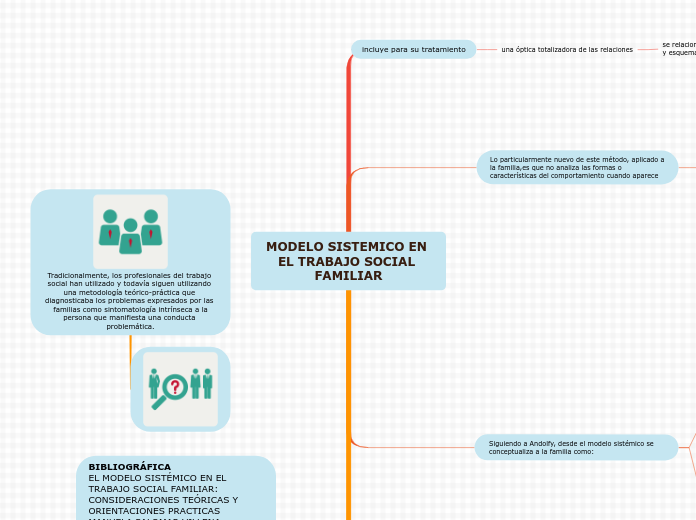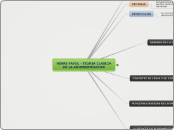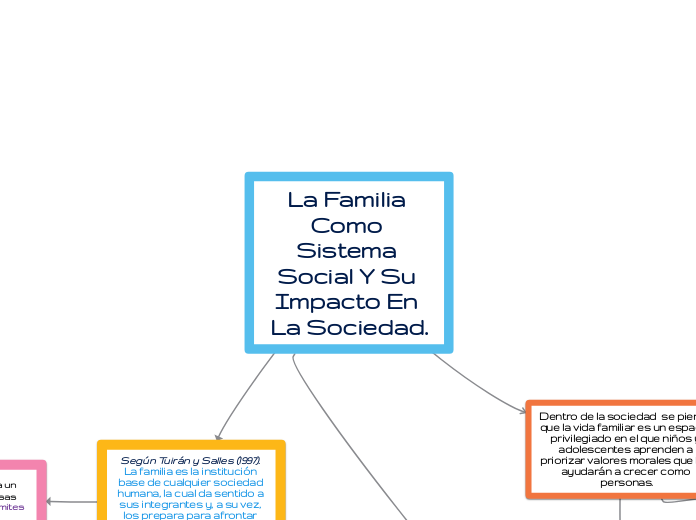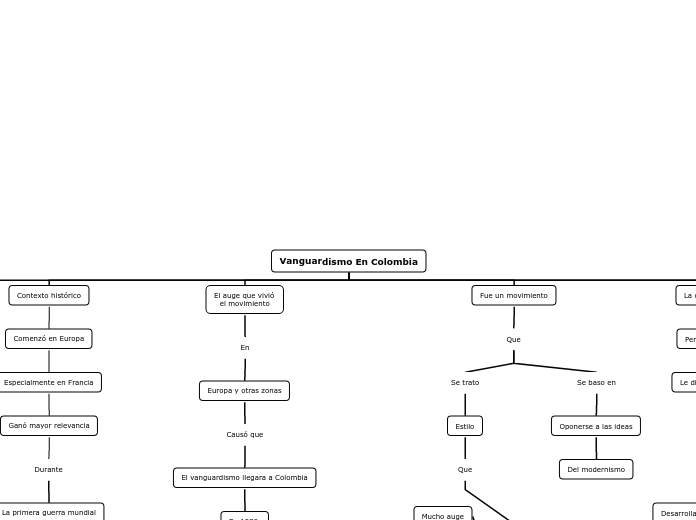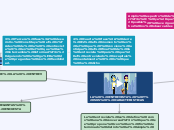MODELO PSICODINÁMICO Y MODELO SISTÉMICO EN TRABAJO SOCIAL Autora: Estefanía Lourdes Álvarez Bueno. Obtenido de http://dspace.ucuenca.edu.ec/bitstream/123456789/21533/1/tesis.pdf
BIBLIOGRÁFICA EL MODELO SISTÉMICO EN EL TRABAJO SOCIAL FAMILIAR: CONSIDERACIONES TEÓRICAS Y ORIENTACIONES PRACTICAS MANUELA PALOMAR VILLENA ESPERANZA SUAREZ SOTO. Obtenido de : https://rua.ua.es/dspace/bitstream/10045/5868/1/ALT_02_10.pdf
Tradicionalmente, los profesionales del trabajo social han utilizado y todavía siguen utilizando una metodología teórico-práctica que diagnosticaba los problemas expresados por las familias como sintomatología intrínseca a la
persona que manifiesta una conducta problemática.
MODELO SISTEMICO EN EL TRABAJO SOCIAL FAMILIAR
To name your story, you have to think about the overall message and what you want your audience to understand from the story. Also, make it relevant and easy to remember.
https://www.youtube.com/watch?v=IqbqdnnAPgs
La estructura de la Familia
Según Minuchin la estructura familiar es «el conjunto de demandas funcionales encargadas de organizar la interacción de los miembros dentro y fuera del sistema. Dentro de esa organización y para que se produzca la interacción, se crean pautas y patrones de conducta, en los que están insertos, deforma implícita, toda una carga de valores, secretos, normas, sistemas de creencias, reglas, mitos., etc., que son introducidas en el sistema familiar de generación en generación, confirmando estructuras determinadas de comunicación sistémicas».
El descubrimiento de la estructura familiar y la comunicación del sistema se realiza con la técnica más importante de este modelo
LA ENTREVISTA
La primer entrevista
La entrevista sistémica es utilizada como el recurso por excelencia de este modelo en el trabajo social con familias. Mediante la entrevista, se recoge información de toda la familia, la cual no sólo es utilizada para la realización de un diagnóstico sino que encierra una intervención en sí misma. La primera entrevista es el momento más importante de todo el proceso.
se estructura de
Subtopic
Planteamiento, definición o estudio del problema
Fase social.
Definición de los cambios deseados.
FASES
Sugerencias para esta primera entrevista
Observaciones preliminares
Siguiendo a Andolfy, desde el modelo sistémico se conceptualiza a la familia como:
The ending of a story is essential. We all know that if the ending is weak, what happened before loses its importance. So make it unpredictable, but fair. A resolved ending answers all the questions and ties up any loose threads from the plot.
Por tanto, una familia es una totalidad, no una suma de partes, que funciona en el tiempo por la interdependencia de las partes entre sí y los demás sistemas que la rodean
This is the closure section of the story.
See examples of possible outcomes below:
- all problems have been solved
- it's clear how each one of your characters ends up
- your main character is transformed by the challenge
«un conjunto constituido por varias unidades vinculadas entre sí por medio de una estructura de relaciones formalizadas.La familia tiene historia propia, se han ligado en el tiempo diferenciándose de su entorno a la vez que participan en él y con él. El cambio de estado de una unidad del sistema va seguido por el cambio de las demás unidades; y éste va seguido por un cambio de estado de la unidad primitiva y así sucesivamente.
This is the moment when the main character surpasses the last obstacle and finally faces their greatest challenge.
The climax usually follows one of these patterns:
- realization
- resolution
- choice
Type in your answer.
Lo particularmente nuevo de este método, aplicado a la familia,es que no analiza las formas o características del comportamiento cuando aparece
The middle of the story is where you add layers of complications that will lead to the end. Reveal more about the character's journey. Did their personality go through changes? How did they overcome the challenges? And as you build up the story’s central conflict, make it more personal to that character. Also, from the middle act, you have to lead into the final act.
VARIABLES A CONSIDERAR EN LA EXPLICACIÓN SISTEMICA DE LOS PROBLEMAS
Temporales
Espacio
incluye para su tratamiento
In the beginning of the story (or the exposition), you will need to introduce the setting and characters. You might also want to introduce the main conflict. This part of the story is important because it gives the reader necessary background information and maybe even a first insight into a character’s personality.
una óptica totalizadora de las relaciones
Characters are essential to a good story. Usually, the protagonist(s) is/are the most affected by the plot. Introduce a character by focusing on their actions, interests, and occupation, as the physical appearance doesn't make a difference in most cases.
se relacionan, de diversas formas, con los conceptos y esquemas operativos desarrollados por
Type in the name of your character.
la Teoría de la Comunicación.
What is your character's main goal?
fight Evilfind lovedefeat his/her enemyrule the worldmake friendstime travelmake an awesome discoveryOther
la Teoría General de los Sistemas
Which traits best describe the character's personality? Choose more if necessary:
introvertedloyalkindindependentquick-thinkingadventuresomeidealisticsweet-naturedcalmrisk-takercreativewittystrictfussyweirdclumsyharshaggressivecarelessclingingcowardlycrueldeceitfulimpulsiveOther
Cibernetica
Choose the type of your chacter:
Protagonist (main character)Antagonist (main character's opponent)Flat (stereotypical character)Round (his/ her personality develops throughout the story)Static (doesn't evolve as a person throughout the story)Dynamic (dramatical change in personality)Confidant (the main character trusts him/ her)Foil (contrasting character who enhances the personality of another character)Other
